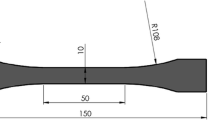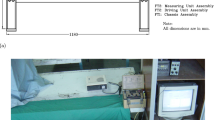Abstract
The recent development of snap-curing epoxy resins and rapid manufacturing processes has led to increased usage of fiber-reinforced plastic composite materials in high-volume production vehicles. For energy absorbing composite structures, characterizing the epoxy strain rate-dependent response and local failure behaviour is critical to assess their crashworthiness performance. The current study investigated the tensile and compressive deformation response of a three-part snap-cure epoxy resin over a range of strain rates (i.e., \({10}^{-4} {\text{to}} {10}^{3} {{\text{s}}}^{-1}\)) using a suite of testing apparatuses. The average tensile elastic modulus, yield strength, and ultimate strength increased by 32%, 55%, and 49%, respectively, with increasing strain rate over the range considered. Tensile specimens fractured in a brittle manner despite deforming plastically, while fracture surface morphology was slightly influenced by the strain rate. The compressive elastic modulus was insensitive to increasing strain rate, while the compressive yield strength increased by 81% over the strain rates considered and was higher than the tensile yield strength at similar strain rates. This study addresses a critical gap in the literature by providing a comprehensive data set for a snap-cure epoxy material, which will support future development of a virtual multiscale-modeling framework aimed at predicting impact performance of composite automotive structures.
















Similar content being viewed by others
Data Availability
Data is available upon request.
References
Elmarakbi A (2014) Overview of composite materials and their automotive applications. In: Elmarakbi A (ed) Advanced composite materials for automotive applications: structural integrity and crashworthiness. John Wiley & Sons, Chichester, pp 3–28
Cherniaev A, Zeng Y, Cronin D, Montesano J (2019) Quasi-static and dynamic characterization of unidirectional non-crimp carbon fiber fabric composites processed by HP-RTM. Polym Testing 76:365–375
Malnati P, Sloan J (2018) CompositesWorld. https://www.compositesworld.com/articles/fast-and-faster-rapid-cure-epoxies-drive-down-cycle-times. Accessed 11 May 2022
Robins J, Wright CD (1987) Fast curing epoxy resin compositions. United States Patent 4,668,736
Morley TA, Koeniger R, Reimers M, Cate P, Jelic N, Sikman Z (2016) Novel epoxy resin system for making carbon fiber composites. International Patent WO2016/209864A1, 29 12 2016
Padarthi Y, Kuppusamy RRP, Neogi S (2023) Recent advances in characterization of rapid cured composite materials. In: Hameed N et al (eds) Rapid cure composites: materials, processing and manufacturing. Woodhead Publishing, Cambridge, pp 149–178
Perry JI, Walley SM (2022) Measuring the efect of strain rate on deformation and damage in fibre-reinforced composites: a review. J Dyn Behav Mater 8:178–213
Morelle XP, Chevalier J, Bailly C, Pardoen T, Lani F (2017) Mechanical characterization and modeling of the deformation and failure of the highly crosslinked RTM6 epoxy resin. Mech Time Depend Mater 21:419–454
Goldberg RK, Robertsa GD, Gilat A (2003) Incorporation of mean stress effects into the micromechanical analysis of the high strain rate response of polymer matrix composites. Compos Part B 34(2):151–165
Chen W, Lu F, Cheng M (2002) Tension and compression tests of two polymers under quasistatic and dynamic loading. Polym Testing 21(2):113–121
Hasan OA, Boyce MC (1995) A constitutive model for the nonlinear viscoelastic viscoplastic behavior of glassy polymers. Poly Eng Sci 35(4):331–344
Brown R (1999) Handbook of polymer testing: physical methods. CRC Press, New York
Gerlach R, Siviour CR, Petrinic N, Wiegand J (2008) Experimental characterisation and constitutive modelling of RTM-6 resin under impact loading. Polymer 49(11):2728–2737
Littell JD, Ruggeri CR, Goldberg RK, Roberts GD, Arnold WA, Binienda WK (2008) Measurement of epoxy resin tension, compression, and shear stress-strain curves over a wide range of strain rates using small test specimens. J Aerosp Eng 21(3):162–173
Werner B, Daniel I (2014) Characterization and modeling of polymeric matrix under multi-axial static and dynamic loading. Compos Sci Technol 102:113–119
Boyce MC, Parks DM, Argon AS (1988) Large inelastic deformation of glassy polymers. Part I: rate dependent constitutive model. Mech Mater 7(1):15–33
Argon AS (2013) The physics of deformation and fracture of polymers. Cambridge University Press, New York
Pae KD, Bhateja SK (1975) The effects of hydrostatic pressure on the mechanical behavior of polymers. J Macromol Sci 13(1):1–75
Parry EJ, Tabor D (1974) Pressure dependence of the shear modulus of various polymers. J Mater Sci 9:289–292
Gilat A, Goldberg RK, Roberts GD (2007) Strain rate sensitivity of epoxy resin in tensile and shear loading. J Aerosp Eng 20(2):75–89
Jordan JL, Foley JR, Siviour CR (2008) Mechanical properties of Epon 826/DEA epoxy. Mech Time Depend Mater 12:249–272
Tamrakar S, Ganesh R, Sockalingam S, Haque BZ, Gillespie JW Jr (2018) Experimental investigation of strain rate and temperature dependent response of an epoxy resin undergoing large deformation. J Dyn Behav Mater 4:114–128
Siviour C, Jordan J (2016) High strain rate mechanics of polymers: a review. J Dyn Behav Mater 2:15–32
Mattucci S, Moulton J, Chandrashekar N, Cronin D (2012) Strain rate dependent properties of younger human cervical spine ligaments. J Mech Behav Biomed Mater 10:216–226
Ouellet S, Cronin D, Worswick M (2006) Compressive response of polymeric foams under quasi-static, medium and high strain rate conditions. Polym Testing 25(6):731–743
Salisbury C (2001) Spectral analysis of wave propagation through a polymeric Hopkinson Bar. M.S. thesis, Waterloo, Ontario, Canada: Department of Mechanical and Mechatronics Engineering, University of Waterloo
Gray GT III (2000) Classic split-Hopkinson pressure bar testing. In: Kuhn H, Medlin D (eds) Mechanical testing and evaluation. ASM handbook, vol 8. ASM International, Detroit, pp 462–476
Sligtenhorst CV, Cronin DS, Brodland G (2006) High strain rate compressive properties of bovine muscle tissue determined using a split Hopkinson bar apparatus. J Biomech 39(10):1852–1858
Wasley RJ, Hoge KG, Cast JC (1969) Combined strain Gauge-Quartz crystal instrumented Hopkinson split bar. Rev Sci Instrum 40(7):889–894
Chen W, Lu F, Zhou B (2000) A quartz-crystal-embedded split Hopkinson pressure bar for soft materials. Exp Mech 40:1–6
Chen W, Zhang B, Forrestal MJ (1999) A split Hopkinson bar technique for low-impedance materials. Exp Mech 39:81–85
Frew DJ, Forrestal MJ, Chen W (2002) Pulse shaping techniques for testing brittle materials with a split Hopkinson pressure bar. Exp Mech 42:93–106
Frew DJ, Forrestal MJ, Chen W (2005) Pulse shaping techniques for testing elastic-plastic materials with a split Hopkinson pressure bar. Exp Mech 45(2):186–195
Zhao H, Gary G, Klepaczko JR (1997) On the use of a viscoelastic split Hopkinson pressure bar. Int J Impact Eng 19(4):319–330
Bacon C (1998) An experimental method for considering dispersion and attenuation in a viscoelastic Hopkinson bar. Exp Mech 38:242–249
Salisbury CP, Cronin DS (2009) Mechanical properties of ballistic gelatin at high deformation rates. Exp Mech 49:829–840
Salisbury C, Cronin D, Lien F (2015) Deformation mechanics of a non-linear hyper-viscoelastic porous material, part I: testing and constitutive modeling of non-porous polychloroprene. J Dyn Behav Mater 1:237–248
Liu Q, Subhash G (2006) Characterization of viscoelastic properties of polymer bar using iterative deconvolution in the time domain. Mech Mater 38(12):1105–1117
Gorham DA (2000) A numerical method for the correction of dispersion in pressure bar signals. J Phys E Sci Instrum 16(6):477–479
Benatar A, Rittel D, Yarin A (2003) Theoretical and experimental analysis of longitudinal wave propagation in cylindrical viscoelastic rods. J Mech Phys Solids 51(8):1413–1431
Salisbury C (2001) Spectral analysis of wave propagation through a polymeric Hopkinson Bar [Master's dissertation, University of Waterloo], UWSpace, Waterloo http://hdl.handle.net/10012/799
Semeliss M, Wong G, Turtle M (1990) The yield and post-yield behavior high-density polyethylene. NASA-Langley Research Center Grant No. NAG-I-974.
ASTM International (2015) ASTMD638: standard test method for tensile properties of plastics. ASTM International, West Conshohocken
Hsieh T, Kinloch A, Masania K, Taylor A, Sprenger S (2010) The mechanisms and mechanics of the toughening of epoxy polymers modified with silica nanoparticles. Polymer 51(26):6284–6294
Sharifpour F, Montesano J, Talreja R (2022) Micromechanical assessment of local failure mechanisms and early-stage ply crack formation in cross-ply laminates. Comp Sci Technol 220:109286
Morelle X (2015) Mechanical characterization and physics-based modeling of highly-crosslinked epoxy resin (Ph.D. dissertation). Université catholique de Louvain, Louvain-la-Neuve
Roulin-Moloney AC (1989) Fractography and failure mechanics of polymers and composites. Elsevier Applied Science, London
Acknowledgements
This study was funded by the Natural Sciences and Engineering Research Council of Canada (NSERC) through Collaborative Research and Development Grant No. CRDPJ-507776-16, as well as the industrial sponsors Honda Research Institute US, Westlake Epoxy, Zoltek Corp., and Laval.
Author information
Authors and Affiliations
Contributions
Y.Z. performed all the experiments and analyzed the data, while D.C. and J.M. verified the results. D.C. and J.M. supervised Y.Z. and provided resources for the study. J.M. administered the project and acquired funding. Y.Z. wrote the original manuscript draft. D.C. and J.M. reviewed and edited the manuscript.
Corresponding author
Ethics declarations
Conflict of interest
None.
Additional information
Publisher's Note
Springer Nature remains neutral with regard to jurisdictional claims in published maps and institutional affiliations.
Appendices
Appendix A
The cylindrical and dog-bone specimens shown in Table 1 for the tensile tests were analyzed using the commercial Finite Element (FE) software, Abaqus (Dassault Systèmes, Vélizy-Villacoublay, France). FE models were constructed for both specimen geometries (Fig. 17), employing the Johnson–Cook plasticity material model calibrated with quasi-static tensile test data presented in this paper. Mesh sensitivity was investigated, and a 0.2 mm mesh size was chosen for the models. Boundary conditions were set to emulate quasi-static tensile tests, applying displacement to the reference point, and corresponding reaction forces were calculated through simulations. The extension of the specimens was measured in the gauge section, mirroring the experimental digital image correlation (DIC) analysis. Numerical simulation results indicated that the stress and strain curves for the two specimen types differed by less than 1% (Fig. 18). Consequently, the impact of the two specimen geometries on the tensile response of the polymer is deemed to be negligible.
Appendix B
To firmly mount the specimens onto the polymer bars (minimize the free movement of the specimen), a tapered thread clamping fixture was designed and manufactured (refer to Fig. 19). The clamping fixture consists of four parts: one RH connector (linked to the RH male thread side of the specimen), one LH connector (linked to the LH male thread side of the specimen), and two RH female thread rings. The downside of employing the fixture is an elevation in geometric impedance and mass. In comparison to a solid bar, the fixture exhibits an 8% increase in mass.
Rights and permissions
Springer Nature or its licensor (e.g. a society or other partner) holds exclusive rights to this article under a publishing agreement with the author(s) or other rightsholder(s); author self-archiving of the accepted manuscript version of this article is solely governed by the terms of such publishing agreement and applicable law.
About this article
Cite this article
Zeng, Y., Cronin, D. & Montesano, J. Characterization of the Strain Rate-Dependent Deformation Response and Fracture Behaviour of a Three-Part Snap-Cure Epoxy Resin Under Tension and Compression Loading. J. dynamic behavior mater. (2024). https://doi.org/10.1007/s40870-024-00419-9
Received:
Accepted:
Published:
DOI: https://doi.org/10.1007/s40870-024-00419-9







